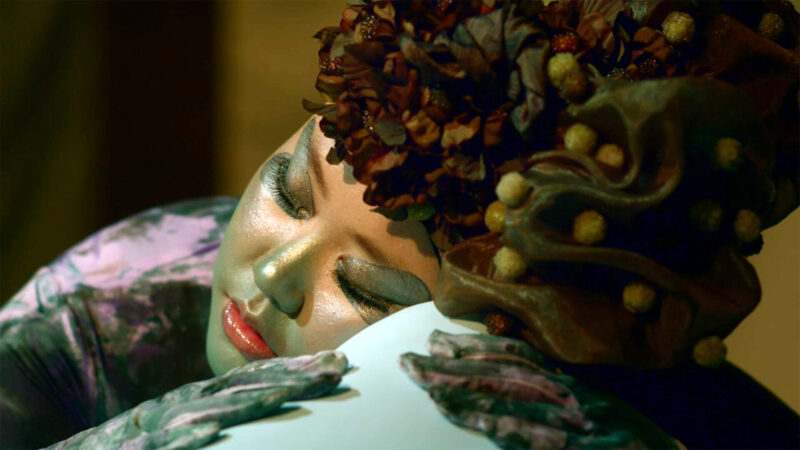DASCHNER
Katrina Daschner

DASCHNER
Katrina Daschner
Katrina Daschner’s exhibitions, spatial choreographies, films and stage performances investigate processes of lust and power as well as artistic staging, and also question traditional gender stereotypes.
Kunstpavillon, Innsbruck, Kleiner Hofgarten: as a rule, visitors to the garden pavilion – constructed as a tea salon in 1842 and converted to create the skylight gallery space in 1951 – enter the exhibition area directly from the terrace. Daschner separated the lobby with cloakroom and toilets from the actual scene of the action. We entered it through a door opening with a curtain and stepped onto a stage. Stage (Material: Las Vegas) was a monumental installation consisting of two glittering curtains of tinsel, which transformed the exhibition space into a theater and appeared to alter the cubature of the Kunstpavillon in a decisive way. Here, the artist presented six hand-produced, embroidered pictures, which could be read as storyboards or technical drawings for stage sets, and evolved parallel to the film works during the development process. The curtain rises (Las Vegas #2, 2015), the lights go on (Lichtstrahl, 2012 and Light curve, 2015), the performers are brought into position (Bertha, 2012) and the curtain falls (Final curtain, 2015). The performance ended where it began: backstage (Panele, 2015). In order to pass into the darkened cinema space, one had to walk through a second curtain of tinsel.
Since 2012 Daschner has been working on a nine-part film series based on Arthur Schnitzler’s Dream Story. Three of the works, which will eventually create a film opera when shown together, have already been completed. Parole Rosette (2012) and Powder Placenta (2015) were presented in the Kunstpavillon. A silvery curtain of threads rises, and we can see human figures standing in the spotlight, clothed in light-blue, shimmering one-piece suits with tubes reminiscent of umbilical cords emerging from their heads. Cut. An idyllic landscape reminding us of Arcadia, an illusionist mural painting, appears – and birds begin to twitter. Light-grey fur moves to the rhythm of relaxed breathing and a person asleep, wearing a vegetable costume, is found in a place of bliss, free of every affliction. Wolves sleep or trot around contentedly. People awake with innocent, aston-ished looks on their faces and smile, and the lush painted landscape reveals birds, fruits, buds and blossoms. The actors stroke sculptures reminiscent of sex toys and expose decorated breasts and genitals. The harmony that lies over these scenes is not stable; it suggest a state in-between. These people, animals and plants seem to be in a place where differentiation – into classes, species and races, or into the different sexes – has not yet taken place. Nothing can be categorized and everything is ambivalent. Nevertheless, this uncertainty suggests no threat. The media of stage and film are unstable per se and so they allow productive dialogue between a wide range of levels. The mural paintings that play an essential part in Powder Placenta are located in Castle Harmannsdorf in Lower Austria, the sala terrena of a former grain store in which performances have been taking place since the Baroque, and where Bertha von Suttner also acted in theater during the late 19th and early 20th centuries. Daschner, whose interest in theater spaces is always focused on hierarchies – the relationships between the audience and the artistic staging – finds an ideal performance setting here for the paradisal scenes of Powder Placenta: a place not oriented on the frontal stage, also highlighting the interface with nature, or rather making nature into its backdrop.
Things are entirely different in the spectacular auditorium of the Teatro Regio in Turin. The focus is on the proscenium stage. At least, until the lights go up: then the atmosphere is dominated by the red velvet seats and the splendid ceiling area with the bombastic chandelier created by innumerable suspended rod lights. Details from this theater dating from the 18th century, which was redesigned by Carlo Mollino after a fire and reopened in 1973, are interspersed with sequences of a strictly choreographed, marching troupe of queers in the film Parole Rosette. Despite their amazon-like, sculptural uniforms, each person retains their individuality. Mechanically, they run through their group choreography and follow the director’s instructions: “No romance!”. There seems to be more emotion in the close-ups of seats and the ceiling than in the faces of the performers. Katrina Daschner regards all objects, stage sets and the stage as subjects to the same degree as people. Free of hierarchy, all the levels are interlocked and address one another via the cinematic stylistic means of montage. The lusting luster makes the performers’ lust obvious. Just as the unexplained level of gender in Powder Placenta is paralleled by the undetermined theater space of Castle Harmannsdorf, where there is no specified section for the audience.
The non-linear narrative method and the protagonists’ position changes in the films were underlined in Daschner’s solo exhibition by the dramatic staging of the space and the involvement of the visitors in it. How many individual truths are contained in dream worlds, which direct our attention to unimagined or at least unvoiced needs and desires…
The aspects of Schnitzler’s Dream Story that interest Katrina Daschner alongside the immensely visual nature of the text, an almost cinematic quality, are the ambiguity of dream and reality, the sphere between reality and fiction, and the fact that inner perceptions and the assumed outside world are inseparable. Fluctuation between the conscious and the subconscious discloses an infinite number of associative levels.
Katrina Daschner * in Hamburg. studied at the University of Applied Arts in Vienna with Brigitte Kowanz (1995-2000). She ran the performance space Salon Lady Chutney (2001-02) with Johanna Kirsch and Stefanie Seibold. She hosted the queer Club Burlesque Brutal (2009–14) at brut/Konzerthaus in Vienna. www.katrinadaschner.net